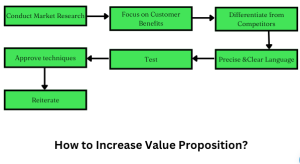Value Proposition
Definition
A value proposition is a statement that summarises the unique benefit that a product or service provides to its customers and why it is better than similar offerings in the market.
Description
It is a statement that explains why a customer should choose a particular product or service over others in the market. It identifies a company’s unique value to its customers and how it solves their problems or satisfies their needs. A good value proposition is clear, concise, and targeted to the specific customer segment for which the product or service is intended.

It should address the customer’s pain points, highlight the product or service’s benefits, and differentiate it from the competition. It is a critical element of a company’s marketing strategy. It helps attract and retain customers by creating a solid and compelling reason for them to choose the company’s offering.
Importance of Value Proposition
It is an essential component of a company’s marketing strategy, and its importance lies in several key areas:
- Customer focus: It forces a company to focus on its customers and their needs rather than just its products or services. By identifying what sets it apart from the competition and how it can solve customers’ problems, a company can create a more customer-centric approach to business.
- Differentiation: A strong value proposition helps a company differentiate itself. Highlighting its unique value and benefits allows a company to stand out in a crowded marketplace and attract more customers.
- Communication: A clear and concise proposition helps a company communicate its value to customers, investors, and other stakeholders. It provides a simple and memorable message that can be used in marketing materials, sales pitches, and other communications.
- Sales and revenue: A well-crafted proposition can increase sales and revenue. A company can attract customers and generate more revenue by addressing customer’s pain points and offering a compelling solution.
How to increase Value Proposition?
There are several ways a company can increase its value proposition:

- Conduct market research: Conducting market research can help a company better understand its target customers, their needs, and what they value most in a product or service. This information can be used to refine the company’s value proposition to better meet the needs of its customers.
- Focus on customer benefits: A company’s proposition should focus on the benefits it’s product or service provides customers rather than just its features. By highlighting the value that customers will receive, a company can make its proposition more compelling.
- Differentiate from the competition: A strong proposition should highlight what differentiates a company. By identifying unique features or benefits that competitors don’t offer, a company can differentiate itself and make its proposition more attractive.
- Use precise language: It should be communicated in clear, concise language that is easy for customers to understand. Avoid using technical jargon or complex language that could confuse customers.
- Test and iterate: A company should test its value proposition with real customers and be willing to change based on their feedback. This iteration process can help a company refine over time and make it more effective.
Value Proposition for the Future
As we move towards the future, the importance of a strong proposition will only increase. Here are some key elements that can make it effective in the future:
- Sustainability: With growing concern about the environment and the impact of human activities, companies that can demonstrate a commitment to sustainability will have a strong value proposition. This could include using eco-friendly materials, reducing waste, or implementing renewable energy sources.
- Personalization: Customers increasingly expect personalised products and services tailored to their needs and preferences. Companies that can offer personalised experiences will be strong in the future.
- Technology: As technology advances, companies that can leverage it to improve their products or services will have a strong proposition. This could include using artificial intelligence, virtual reality, or other cutting-edge technologies to enhance the customer experience.
- Transparency: With the rise of social media and other forms of communication, customers expect transparency from companies. Companies that can demonstrate honesty and transparency in their operations will have a strong proposition in the future.
- Social Impact: Customers are increasingly looking for companies with a positive social impact. Companies that can demonstrate a commitment to social responsibility and giving back to the community will have a strong proposition in the future.
Ways to Create Value Proposition.
Creating a compelling proposition involves several steps:

- Identify your target customer: It’s important to understand who your target customer is and what they value most in a product or service. This information can be gathered through market research, customer surveys, or customer data analysis.
- Understand customer needs: Once you have identified your target customer, it’s essential to understand their needs and pain points. This can be done through research, analysis, and conversations with customers.
- Identify your unique value: To create a strong value proposition, you must identify what sets your product or service apart from the competition. This could be a special feature, a better quality product, or a more affordable price.
- Craft your message: Once you have identified your unique value, you need to craft a clear and compelling message that communicates this value to your target customer. The letter should be simple, easy to understand, and focused on your product or service’s benefits to customers.
- Test and refine: Once you have developed it, it’s essential to test it with real customers and be willing to make changes based on their feedback. This iteration process can help you refine your proposition and make it more effective.
Example
One Indian brand example of a strong value proposition is Amul, a dairy products company. Amul’s proposition is “The Taste of India”, which communicates its commitment to producing high-quality, locally-sourced dairy products uniquely Indian.

Amul has built its value proposition on a number of key elements. Firstly, it emphasises the importance of using locally-sourced milk to support Indian farmers and ensure the freshest, highest-quality products. Secondly, it offers a wide range of dairy products that are tailored to the unique tastes and preferences of Indian consumers. Finally, Amul has built a strong reputation for quality and reliability, with its products widely recognized as some of the best in the Indian market.
By focusing on these critical elements, Amul has created a compelling value proposition that resonates with Indian consumers. Its commitment to quality, local sourcing, and uniquely Indian flavours has helped it become one of the country’s most trusted and beloved brands.
FAQ
What is a value proposition?
It is a statement that communicates the unique benefits that a product or service provides to its customers. It answers, “Why should I buy this product or service?”
Why is a value proposition important?
It is important because it helps a company differentiate itself from its competitors and communicate its unique value to customers. It can also help attract and retain customers by demonstrating how the product or service meets their needs and provides a better solution than the competition.
What are the critical elements of a strong value proposition?
A strong proposition should be clear, concise, and focused on the product or service’s benefits to customers. It should target a specific audience and address their unique needs and pain points. It should also be differentiated from the competition and communicate an outstanding value that sets it apart.
How can I create a value proposition for my product or service?
To create a value proposition, you must identify your target customer, understand their needs and pain points, and place your unique value proposition. You can then craft a clear and compelling message that communicates this value to your target audience.
How can I test the effectiveness of my value proposition?
You can test your proposition’s effectiveness by getting customer feedback through surveys, focus groups, or by analysing customer behaviour and engagement. You can then use this feedback to refine your value proposition and make it more effective.





We would love to have your opinion.